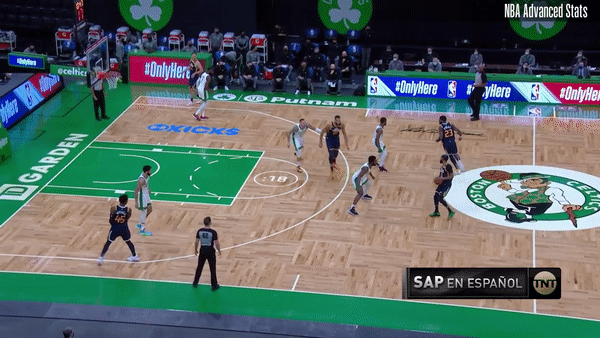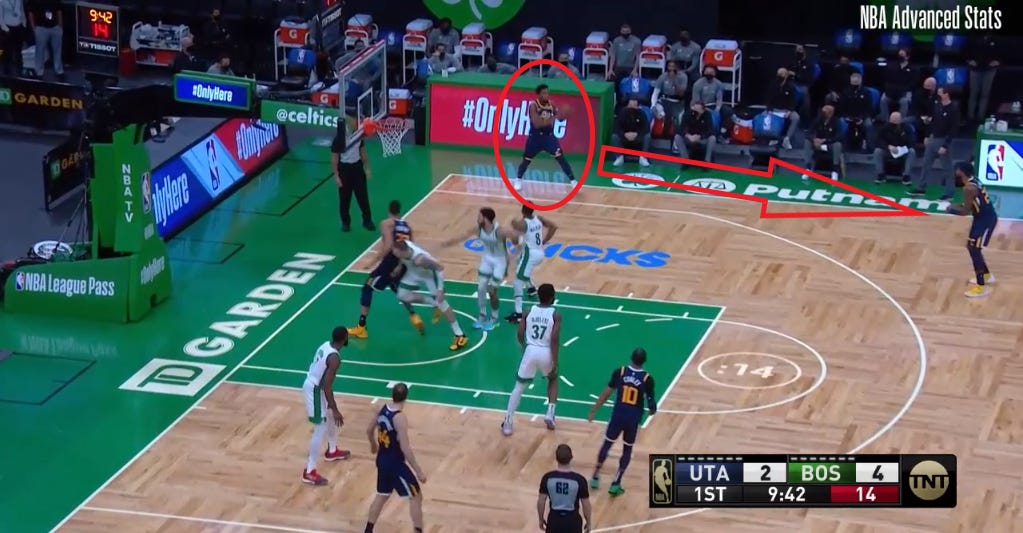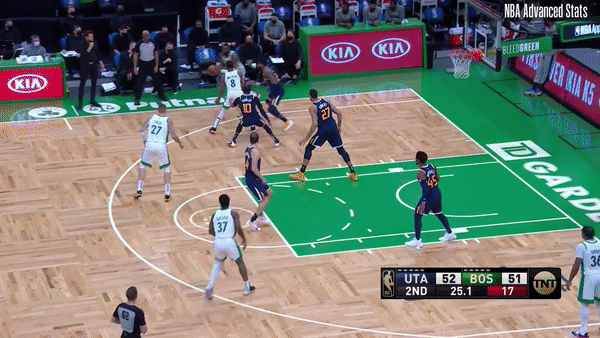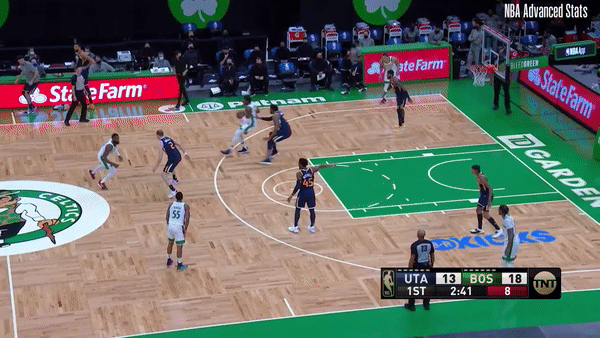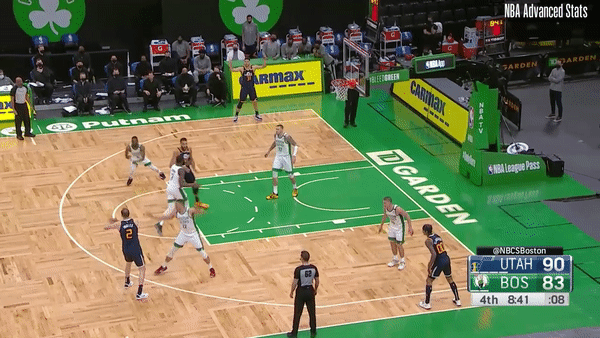Weekly Rewatch 4: Celtics-Jazz
A Conley favorite, the Jazz ALWAYS make the right pass, intriguing Timelord, and the Celts need easier shots.
This is the fourth in a recurring series; in previous installments I looked at Bucks-Pelicans, Nets-Clippers, and Heat-Jazz matchups. I would love suggestions/requests for games that you would like to see featured in this space going forward.
Taking digs at the Utah Jazz is a favorite in some quarters of NBA fandom. Jokes aside, they truly are a joy to watch. There is a little bit of the Summertime Spurs in how they always make the right pass and find the best shot on offense. I mean, if this possession isn’t art:
Post All Star Game stumbles aside, the Jazz are legit. The Boston Celtics on the other hand have sputtered along and are squarely in the Eastern Conference play-in picture.1 Two broad trends that made this matchup between the two teams intriguing: Utah takes away the arc and the rim, happy to allow teams to fire away from the mid-range. No team gives up fewer 3s per Cleaning the Glass; the Jazz run teams off the arc and funnel them towards Rudy Gobert and Derrick Favors at the rim. With the former as a deterrent in particular, teams attempt a high proportion of their shots from the mid-range versus the Jazz. Meanwhile, the Celtics take a healthy chunk of their shots from the mid-range, ranking bottom-ten in the proportion of shots that come at the rim and from 3.
The second thing to keep an eye on was the transition game. Boston’s transition defense is a tick below league average this season per Cleaning the Glass, a big dropoff given that Brad Stevens’ teams have typically been right at the top of the league in this category.2 This dropoff is driven primarily by their transition defense off missed shots; the Celtics give up a dismal 133 points per 100 possessions off live rebounds per Cleaning the Glass. The Jazz meanwhile have the league’s best offense off live rebounds (and the second best transition offense overall), creating another stress point.
Quarter 1: The Jazz leave you no room for error
Watch the whirling Utah Jazz offense and it becomes apparent that they leave teams no room for error. The Jazz players have honed some strong chemisty; they find the holes in a team’s defense and plow right through them. Sometimes the mistakes are easier to capitalize on, like Jayson Tatum not tagging Rudy Gobert on the roll here:
Other times, the mistake opens up an opportunity a couple of passes away. The Jazz always make those passes and get to the kill shot.
Tatum is early on the tag there as the weakside low man. The thing is, Kemba Walker also follows Gobert’s roll. Perhaps the scheme there is for Kemba to tag Gobert early and then peel off to zone up on the weakside. He is late in doing so, but notice Donovan Mitchell in the corner ready to pass the ball to Royce O’Neale on the wing even before the pass gets to him.
The Jazz kill teams by putting them into rotation; it takes a five-man unit operating at the highest level to time all their defensive rotations perfectly, and the Jazz are exploiting anything short of perfection.
The Celtics have enough high-level defenders to raise their level when needed. They did so in the first quarter, forcing Jazz turnovers en route to building up an early lead.
Semi Ojeleye is in position early on Gobert, Kemba Walker times his dig, and Jaylen Brown zones up well on the weakside.
That’s the sort of picture perfect positioning that teams need in order to gum up the Jazz machine. That positioning needs to be accompanied by an intimate knowledge of the other team’s personnel and how to adapt one’s schemes accordingly. The Celtics opened the game with their bigs dropping back on pick and rolls, something that the Jazz exploited early.
Robert Williams is in a deep drop, allowing Joe Ingles to step right into a pull-up three. Amongst players who have attempted at least fifty such shots this season, Ingles is fifth in the league in accuracy (42.6%) per NBA advanced stats. That’s a big jump from his mark of 35% the previous season, but we have enough of a sample now where teams need to be wary of giving Ingles that much space in the pick and roll. Again, the Jazz punish any and every mistake. Williams will shelve this away, as we see later.
The first quarter also provided an early indication that the Jazz were going to burn the Celtics in transition off of live rebounds (remember the trend mentioned earlier? The Jazz ultimately added nearly 6 points on the game through those opportunities.) The last three Jazz scores of the quarter all came on such plays and they did it in every which way: a Gobert transition dunk, a Niang offensive rebound and lay-in, and then a Conley pull-up three.
Utah is attempting a lot more of those quickfire transition 3s this season and shooting 42% as a team on those attempts per NBA advanced stats. That clip provides some clue as to why the Jazz are so good in transition - everyone gets to their spots early.
Quarter 2: Jaylen Brown’s decision making
Jaylen Brown is such an easy player to root for. He is a thoughtful leader off the court and a burgeoning star on it. His usage has increased every season and he has made the leap this year on the back of a big leap in scoring, particularly from the mid-range. He attempts over 40% of his shots from the mid-range and shoots reasonably well on those attempts, including nearly 50% on long mid-range shots.
For Brown’s next act, I would love to see him develop a more efficient shot profile and improve his playmaking. Brown’s assist-to-usage rate is middling per CTG and he still turns the ball over a little too often. It occasionally feels like Brown is searching for a plan when he gets to his spot and finds no shot available.
The initial play looks like a Spain pick and roll, but Brown isn’t even looking for Kemba Walker and that option is closed off quickly. Still, with a little patience, Brown has both Marcus Smart on the wing and Semi Ojeleye available in the corner there.
At other times, Brown develops tunnel vision and grits through with a tough shot even when there’s a decent option right in front of him.
Daniel Theis had been making the open mid-range jumper against Rudy Gobert’s drop up to that point. Brown has him open at the free throw line.
Ultimately this might be nothing more than Brown getting more reps; he already assists on nearly 20% of his teammates baskets when he is on the floor and has flashed tantalizing glimpses of pick and roll craft.
That’s lovely timing from Brown, getting Gobert to leave his feet before dropping the pass off to Theis for the easy dunk.
Quarter 3: To beat the switch, embrace the switch
One lingering question around the Jazz offense: How will they deal with a really good switching defense? The Jazz have shown a willingness to throw in ghost screens and slip screens when faced with switches. Opening up the second half of the Celtics game, they took it a step further by actively seeking out defensive switches. On three straight plays, Bojan Bogdanovic went to screen for Mike Conley Jr. in order to get Conley’s man, Kemba Walker, switched on to him.
On the first play here, Bogdanovic posts up Walker for the easy turnaround.
On the next play, Daniel Theis comes over to help, leading to the easy kick out to Royce O’Neale for the open 3.
Gobert’s dive there is a subtle piece of art, pulling Semi Ojeleye out of any position to close out on O’Neale.
The Jazz again went to the Bogdanovic post-up on Kemba on the next play down, drawing a defensive three second violation on Daniel Theis. The Jazz are excellent at executing their schemes; look at Gobert’s positioning below. He keeps enough space between himself and Theis, preventing Theis from tagging Gobert in order to camp out in prime help position.
Finally, on a Jazz sideline out of bounds, the Celtics are sick of giving up the switch after getting scored on on three straight possessions. Anticipating this, the Jazz run a play designed to put Bogdanovic’s man (Jaylen Brown) behind the play with two flare screens.
Although Bogdanovic misses the shot, that’s great play design. Not every team will present a target on defense like Walker, but this sequence is intriguing from the perspective of how Utah schemes against different defensive looks.
Shifting gears a little, go back to the Ingles pull-up from the first quarter when Robert Williams was in a deep drop. Williams learned his lesson and on a similar Favors-Ingles pick and roll, is higher up to put in a contest.
There is a lot about Williams to be intrigued by. He is a smarter defender than people give him credit for, adjusting his coverage to the personnel. When Favors runs a pick and roll with Donovan Mitchell later in the third, Williams goes back to a drop, respecting Mitchell’s threat on the drive and recognizing 1) Jayson Tatum being in good position to put in a contest, and 2) Mitchell being less of a pull-up 3 threat than Joe Ingles.
On the other end of the floor, I would love to see more of this passing spice from Williams:
Williams provides the Celtics with the type of vertical spacing that none of their other bigs provide.
Granted, this is against Derrick Favors and not Rudy Gobert. Given where Williams fetches that from though, you would bet on Brown being able to toss the ball above Gobert as well. Williams’ continued development is something to monitor in terms of the Celtics’ ceiling.
Quarter 4: The Celts need easier shots
The Celtics feel a little bit like the Clippers in so far as both teams have offenses powered by an absence of easy shots (although the Clippers have a much better offense than the Celtics.) Boston has a middling free throw rate. Per Cleaning the Glass, the Celtics have a bottom three location effective field goal percentage (a measure of the team’s shot profile efficiency.) A lot of those mid-rangers are just flat out tough.
That Grant Williams post-up is not the primary option for the Celtics; prior to Williams’ miss, Georges Niang and Joe Ingles navigated a Jaylen Brown screen for Williams, following which Mike Conley did a nice job denying the pass to Kemba Walker. Still, when Williams is scoring a measly 0.53 ppp on post-ups, the Celtics probably need to figure out another option with 10 left on the shot clock.
Even when the Celtics score out of these opportunities, it feels like a win for the defense.
Brown has Theis and Payton Pritchard open beyond the arc, but goes for the tough fadeaway. As the defense, you figure that more of those shots won’t go in than will.
Not to sound like a stuck record, but on the other side, the Jazz are masters of making the right pass and uncorking high value looks. They rank near the top of the league in secondary “hockey” assists. The Jazz will always make the pass that leads to the final pass. Out in transition, Joe Ingles finds Georges Niang, who has a better angle for the lob to Rudy Gobert.
One team had a more efficient offense than the other. While that wasn’t the whole story, sometimes that’s a big part of it, and the Jazz came away with the win.
Mike Conley’s right hand
What is it about southpaws that makes them such an aesthetic joy? Perhaps it is the novelty factor. With Mike Conley, as fun a leftie as there is to watch, it is surprisingly his right hand that especially brings me joy. More specifically, this off hand push shot/floater:
Conley busted that out a few times against the Celtics. Sometimes he throws in a pump fake; even when the defense doesn’t bite, the surprise of his off hand still buys him space.
The shot reaches apex beauty when he flows straight into it from a left-to-right crossover.
I’m so glad Conley made the All Star Team this year.
It would be negligent not to mention that Jayson Tatum is still recovering from Covid and Marcus Smart has barely played. The former in particular is worrying and I wish him and other affected players a speedy recovery and no long-lasting effects.
Ben Falk wrote about how good they were at getting to the full court shell spot a few years back, with Aron Baynes in particular playing an underrated role.


